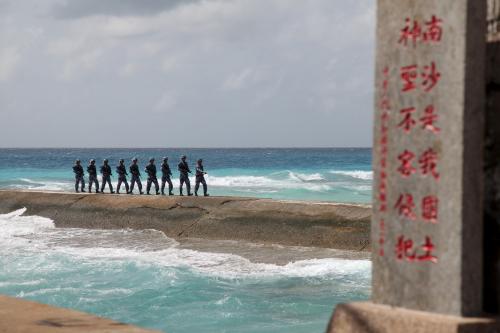China will be hosting the G-20 summit on September 4 and 5. Its deputy foreign minister has said that it wants to avoid sensitive issues, and focus on economic development at the world’s premier forum for international economic cooperation. Indeed, some argue that China has moderated its response to the July 12 arbitral tribunal ruling on the South China Sea so that the issue does not cast a pall over the summit.
China’s stated aim notwithstanding, the South China Sea is almost certainly going to be raised at bilateral meetings surrounding the G-20. It will also be raised in Laos where the U.S.-ASEAN and the East Asia summits will be held the following week. According to a White House press statement, President Barack Obama will “coordinate with the region’s leaders on efforts to advance a rules-based international order” at the East Asia Summit.
Almost two months after the tribunal’s ruling, it is worth taking stock of where the rule of law stands. How has China’s conduct measured up to the ruling?
Immediately after the award was issued, China declared it null and void and of no binding force. It also continues to insist that any negotiations with the Philippines cannot mention the ruling.
Beijing’s actions, however, have been relatively restrained. It has not taken additional, escalatory steps, such as creating a new base on Scarborough Shoal just off the Philippines island of Luzon. It has also not declared an air defense identification zone (ADIZ) over the South China Sea.
These actions would not necessarily be unlawful, though they would significantly raise tensions. The tribunal did not rule on sovereignty over Scarborough Shoal or any other feature in the South China Sea. Many countries, including the United States, employ ADIZs with the aim of protecting national security. State practice varies, but given that freedom of overflight in international airspace cannot be circumscribed, any ADIZ can only be applied to aircraft intending or signaling an intention to enter national airspace, which it would otherwise have no right to do.
Some who accuse China of openly flouting the award cite Beijing’s failure to renounce the dashed line, its continued presence on occupied features, and its island-building and construction activities.
However, the tribunal did not say that the dashed line per se was illegal. It only ruled that insofar as it was a claim to historic rights, this would be inconsistent with the convention.
Further, the tribunal did not touch on whether China’s occupation of land features, as well as its island-building and construction activities, were in and of themselves unlawful since this would depend on the issue of sovereignty.
It confined itself to ruling that Beijing’s island-building and construction activities were unlawful because they violated environmental obligations under the convention, aggravated and extended the ongoing dispute before the tribunal, and had the effect of tampering with evidence.
Where the tribunal found that China’s construction activities were unlawful was at Mischief Reef, a feature China occupied in the mid-1990s, given that such activities were conducted without the Philippines’ authorization. The tribunal found that Mischief Reef was in its natural state a low-tide elevation that is part of the Philippines’ exclusive economic zone (EEZ) and continental shelf.
There have been unconfirmed reports of Beijing speeding up construction activities on Mischief Reef. If true, this would be problematic given the tribunal’s clear finding that it lies within the Philippines’ jurisdiction.
Also problematic are reports of Chinese vessels harassing Philippines fishing vessels around Scarborough Shoal. The tribunal ruled that both China and the Philippines have traditional fishing rights in its territorial sea.
The international community appears to have taken the pragmatic position that there is some room for ambiguity at the margins, but not for a wholesale repudiation of the tribunal’s decision. Thus far, it seems that Beijing has kept its actions within that gray zone.
Things to look out for in assessing China’s conduct after the summit are as follows. First, how China responds if the Philippines begins oil and gas exploration work at Reed Bank, one of the areas in the South China Sea with significant hydrocarbon resource potential. The tribunal found that Reed Bank is an entirely submerged reef formation forming part of the Philippines EEZ and continental shelf.
Second, whether Beijing itself begins exploration at Reed Bank.
Third, whether Beijing makes any moves against Second Thomas Shoal, a feature on which Manila intentionally grounded a vessel in 1999 to prevent China from occupying it. Like Mischief Reef, the tribunal found that Second Thomas Shoal is a low-tide elevation that is part of the Philippines EEZ and continental shelf, and within the Philippines’ exclusive jurisdiction.
Fourth, whether China draws straight baselines around the features in the Spratlys, as it did around the Paracels located in the northern part of the South China Sea in 1996. In a Ministry of Foreign Affairs statement issued on the same date as the tribunal ruling, Beijing appeared to be laying the groundwork for this by stating that “China has internal waters, territorial sea and contiguous zone, based on Nanhai Zhudao [the South China Sea Islands].” Given the tribunal’s ruling that the Spratlys cannot generate maritime zones collectively as a unit, drawing straight baselines around them would be a clear breach of the ruling.
Fifth, whether China declares an ADIZ above the South China Sea. This would not necessarily be unlawful, though it would heighten tensions. China can signal the sincerity of its desire to manage the dispute peacefully by avoiding this act.
How the rule of law fares will also depend on how other states behave. If all states treat the award as authoritative, it will be difficult for China to assert control outside of a 12 nautical mile (nm) zone from the islands it occupies. States should exercise the right of innocent passage within the territorial seas of features in the Spratlys identified as rocks by the tribunal, and high sea freedoms around features identified as low-tide elevations or submerged features. Exercising high sea freedoms through the Spratlys can signal to Beijing that if it wishes to take the escalatory step of declaring unlawful straight baselines around them, it will not be able to defend the waters within them as internal waters without risking confrontation.
Quite apart from holding China to account, states who believe in a rules-based system should also begin to implement the tribunal’s decision in respect of their own claims and activities, especially with regard to the status and entitlement of features, as well as the environmental obligations the ruling clarifies. While the ruling is not binding on non-parties to the dispute, it is an authoritative interpretation of the convention.
On balance, the award has strengthened the rule of law by clarifying provisions in the convention, as well as the areas of overlapping claims—now limited to the 12 nm belts of territorial sea around the disputed islands. This provides the basis for negotiations between claimants to take place.
The underlying issue of sovereignty over islands is unlikely to be resolved in the near- to medium-term, though the award has reduced the significance of who has a better claim to sovereignty by its finding that all features in the Spratlys are at most islands entitled to a 12 nm territorial sea (“rocks”). But this should not stop negotiations to share resources, manage fishing, and protect the marine environment. Negotiations to expand agreements to prevent incidents at sea should also be pursued as an urgent priority.
In all these endeavors, the law plays an important role in providing a backdrop to and framework for peaceful negotiations. It is in the interests of all states, including China, to preserve the rules-based order founded on the generally accepted provisions in the convention. One hopes that China’s relatively moderate response to the tribunal’s ruling thus far has been motivated by a realization that its reputation as a law-abiding power and good relations with its neighbors and the United States are at least as important as, if not decidedly more so than, the narrow goal of being regarded as a good G-20 host.







Commentary
Op-edAssessing the rule of law after the South China Sea arbitration: Will the G-20 be a turning point in China’s behavior?
September 1, 2016